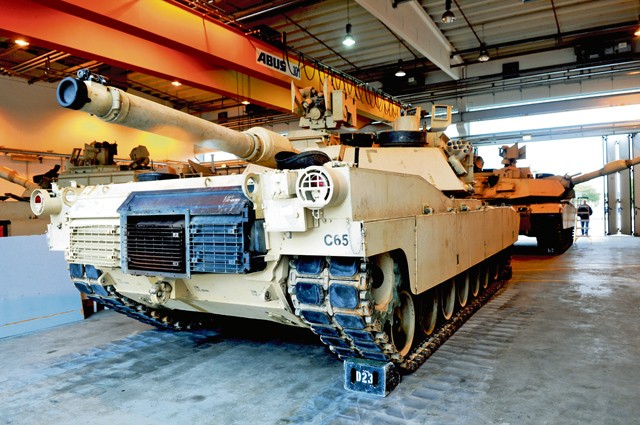
MANNHEIM, Germany — A new era for U.S. forces began quietly and without fanfare in the dreary rain on the nondescript flatlands near Mannheim last week when the 405th Army Field Support Brigade, a partner organization to the 21st Theater Sustainment Command, began its first full issue of European Activity Set equipment to rotational forces from U.S.-based units.
With the removal of two combat brigades from the European theater in recent years, the U.S. Army is relying on rotational forces to fill the gap in both training and operations in theater, and EAS equipping is a critical enabler of the concept.
The EAS is comprised of a combat brigade worth of prepositioned equipment, including 250 tanks, fighting vehicles and self-propelled howitzers staged at EAS sites in Mannheim and Grafenwoehr. This equipment is drawn by rotational forces such as the 1st Brigade Combat Team, 3rd Infantry Division, which will then use it for training exercises with NATO and other partner nations. The forces will remain ready to respond to threats and aggressions against NATO partners and other allies.
Keeping the equipment staged forward eliminates the considerable expense of shipping equipment each time a unit rotates in and out of Europe. It also reduces the amount of time rotating forces spend preparing for deployment and allows Soldiers to focus more time and energy on their mission and training. Finally, the EAS concept reduces the time needed to deploy forces into theater.
Much like individual Soldiers draw their sleeping bag, helmet and other required field gear from a central issue facility, personnel from rotating brigades report to the EAS sites and draw approximately 1,200 major items of equipment, including about 250 tanks, infantry fighting vehicles and self-propelled howitzers.
There are plans to expand the program beyond the two current EAS sites and push EAS sites out into NATO and allied partner nations in Eastern Europe where they will be ready to respond to threats to the region, according to Robin Dothager, 405th AFSB’s prepositioned stock manager. Dothager added that the equipment making up the EAS is not soft-edged training equipment, but the best and most modern warfighting equipment the Army has.
“This equipment is either brand new or freshly refurbished,” Dothager said. “Most of us here (at the 405th AFSB) are old Soldiers ourselves, and we take pride in making sure that we’re putting the absolute best equipment in the hands of these Soldiers.”
The current issue of equipment is expected to continue until mid-October. The 405th AFSB sets a goal of issuing equipment to an entire battalion in a single day; so in theory, an entire brigade could be appropriately “issued” in a matter of days. However, in some cases, such as this first rotation, units do not draw equipment pieces one right after another, instead receiving items on a “staggered” schedule based on specific scheduled training events.
Once their rotation is complete, the Soldiers will return the equipment and the 405th will begin the process of performing maintenance and services to bring the equipment back into tiptop condition for the next rotational force.
By enabling the rotational forces concept, the EAS is a critical part of U.S. Army Europe’s ongoing effort to accomplish the same mission with limited resources, which massive formations of troops accomplished in years past.
“Years ago, the U.S. had 300,000 troops in Europe,” said Lt. Gen. Ben Hodges, USAREUR commanding general, during a recent visit to the Coleman EAS site. “Our mission was to deter aggression. Now we have 30,000. Our mission is still to deter aggression. Our task now is to take the 30,000 and make them act like we still have 300,000.”



